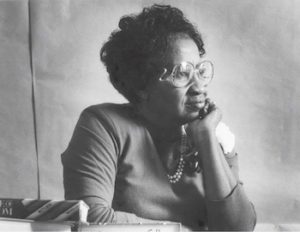
Clara Luper
*Clara Luper was born on this date in 1923. She was a Black schoolteacher and activist.
Clara Mae Shepard was born in 1923 in rural Okfuskee County, Oklahoma. Her father, Ezell Shepard, was a World War I veteran and laborer, and her mother, Isabell Shepard, worked as a laundress. As a child, she was raised in Hoffman, Oklahoma. She went to high school in the all-Black town of Grayson, Oklahoma. In 1944, she received a B.A. in mathematics with a minor in history from Langston University. In 1950, Luper was one of the Black students who integrated into the University of Oklahoma, where she received an M.A. in History Education in 1951.
In 1957, as Luper worked as a history teacher at Dunjee High School east of Oklahoma City, she also became the advisor for the Oklahoma City NAACP Youth Council. At this time, she was deeply influenced by the success of Dr. Martin Luther King Jr. and the Montgomery Bus Boycott. From 1958 to 1964, Luper mentored the members of the NAACP Youth Council during its campaign to end the segregation of public accommodations through sit-ins, protests, and boycotts. With the Youth Council, she wrote and staged a play entitled Brother President about King’s philosophy of nonviolence.
In 1958, she was invited to bring the Oklahoma City Youth Council to perform as Brother President for the NAACP in New York City. Youth Council members' trip to and from New York was a formative experience. On their return to Oklahoma, the Youth Council voted to initiate a campaign of non-violent civil disobedience to end segregation in Oklahoma City. On August 19, 1958, Luper and a group of Youth Council members entered the segregated Katz drugstore in downtown Oklahoma City. They took seats and asked to be served. Two days later, Katz corporate management in Kansas City desegregated its lunch counters in three states.
This successful August 1958 sit-in led by Luper, her eight-year-old daughter who suggested the action, and the rest of the children in the NAACP Youth Council, at the Katz Drug Store occurred a year and a half before February 1, 1960, in Greensboro, North Carolina sit-ins. Luper led the campaigns to gain equal banking rights, employment opportunities, open housing, and voting rights. Along with the NAACP Youth Council, she integrated hundreds of restaurants, cafes, theaters, hotels, and churches, including notable Oklahoma City establishments such as the Split-T drive-in and the Skirvin Hotel. She served on Governor J. Howard Edmondson’s Committee on Human Relations.
Luper was a prominent figure in the American civil rights movement. She was active in the NAACP and attended the association’s annual conference every year with the Oklahoma City Youth Council. She participated in the 1963 March on Washington, where Dr. King gave the “I Have a Dream” speech. She also participated in the 1965 Selma to Montgomery marches, where she received a deep cut in her leg on "Bloody Sunday" when 600 civil rights marchers were attacked by state and local police with tear gas and billy clubs.
After 1964 Luper remained an important community figure as an activist, educator, and stalwart NAACP supporter. In these years, she expanded the range of her concerns to include advocacy for educational, economic, and political equality. In 1968, she was one of a handful of Black teachers hired to teach at Oklahoma City's Northwest Classen High School as part of the highly controversial court-ordered school desegregation plan implemented that year. She was later reassigned to John Marshall High School (Oklahoma), where she continued to teach history and media studies.
In August 1969, Luper was the spokesperson for striking sanitation workers in Oklahoma City. The sanitation workers sought a shorter work week, pay raises, and new grievance procedures. The Oklahoma City sanitation strike began on August 19 and ended on November 7, 1969. In 1972, Luper ran unsuccessfully for election to the United States Senate. In 1979, her book "Behold The Wall"s was published, an acclaimed first-hand account of the campaign for civil rights in Oklahoma City during the 1960s. In 2005, The Clara Luper Corridor, a multi-million dollar two-mile street-scape project connecting the Oklahoma State Capitol complex with the historically African American area of Northeast Oklahoma City, began construction.
Luper received many awards and was inducted into the Oklahoma Hall of Fame, the Oklahoma Women's Hall of Fame, and the Oklahoma Afro-American Hall of Fame, among others. The Clara Luper Scholarship, a full scholarship given by Oklahoma City University, has been awarded to 30-45 students yearly. The scholarship was geared towards minority students from under-served high schools or low-income households. Clara Luper a pioneering leader, died on June 8, 2011.
Encyclopedia of Oklahoma History and Culture,
800 Nazih Zuhdi Dr.,
Oklahoma City, OK, 73105.